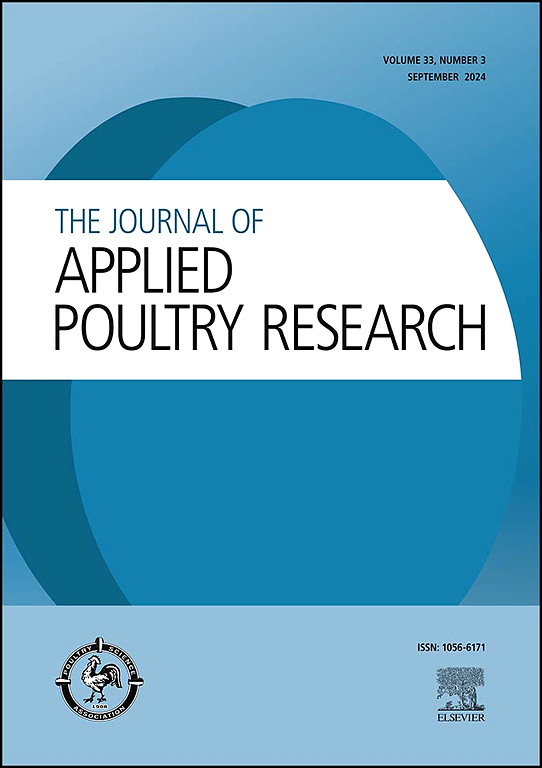Applied research note: Impact of broiler carcass orientation after slaughter on breast meat quality when evaluating delayed processing
IF 2
3区 农林科学
Q2 AGRICULTURE, DAIRY & ANIMAL SCIENCE
引用次数: 0
Abstract
The live transportation and holding of broilers prior to processing may have the potential to cause issues with meat quality. In prior experiments simulating alternative processing procedures, broilers were slaughtered on-farm and bled carcasses were transported to the plant to continue processing. These carcasses exhibited reddish discoloration on the cranial end of the raw breast fillets. Based on these observations, the current experiment tested if holding carcasses by their shanks caused discoloration in the cranial end of the fillets. The objective of this trial was to determine whether carcass orientation (on back, hanging by neck, hanging by shanks) alters breast meat color. At d43, 120 Cobb-500 males were placed into 4 treatments: control (no delay), 4 h delay + held by shanks (4Shanks), 4 h delay + held by neck (4Neck), or 4 h delay + held on back (4Back). All broilers were electrically stunned and bled-out. The control group was immediately hard-scalded and picked, while the delayed processing treatments were all held for 4 h before scalding/picking. Breast fillets were hot-deboned and chilled overnight. All fillets were assessed for petechial hemorrhaging and discoloration (cranial, caudal, and lateral), as well as additional meat quality measurements. Compared to controls, hemorrhaging and discoloration scores were greater for 4Shanks (cranial) (p = 0.0134 and p < 0.0001, respectively), 4Neck (caudal), and 4Back (lateral) (all p < 0.0001). Discoloration scores were supported by a* values of raw fillets. These data suggest that the location of discoloration in the breast fillets was influenced by the carcass holding orientation prior to scalding/picking.
应用研究说明:评价延迟加工时屠宰后肉鸡胴体朝向对胸肉品质的影响
肉鸡在加工前的活体运输和饲养可能会导致肉质问题。在先前模拟替代加工程序的实验中,肉鸡在农场屠宰,流血的尸体被运送到工厂继续加工。这些尸体在生胸片的头端有淡红色的斑点。基于这些观察结果,目前的实验测试了用它们的小腿握住尸体是否会导致鱼片的颅骨末端变色。本试验的目的是确定胴体朝向(背部、颈部悬挂、小腿悬挂)是否会改变胸肉的颜色。在第43天,120只Cobb-500雄性被分为4个处理:对照组(不延迟),延迟4小时+用腿夹住(4Shanks),延迟4小时+用脖子夹住(4Neck),或延迟4小时+用背部夹住(4Back)。所有的肉鸡都被电晕了,血流不止。对照组立即进行硬烫采摘,延迟加工处理均保持4 h后再进行热烫采摘。鸡胸片是热去骨后冷藏过夜的。评估所有鱼片的点状出血和变色(头部、尾部和外侧),以及额外的肉质测量。与对照组相比,4条小腿(颅骨)出血和变色评分更高(p = 0.0134和p <;0.0001),颈部(尾侧)和背部(侧侧)(均p <;0.0001)。变色分数由生鱼片的a*值支持。这些数据表明,鸡胸片变色的位置受烫/采摘前抱尸方向的影响。
本文章由计算机程序翻译,如有差异,请以英文原文为准。
求助全文
约1分钟内获得全文
求助全文
来源期刊

Journal of Applied Poultry Research
农林科学-奶制品与动物科学
CiteScore
4.10
自引率
10.50%
发文量
80
审稿时长
104 days
期刊介绍:
The Journal of Applied Poultry Research (JAPR) publishes original research reports, field reports, and reviews on breeding, hatching, health and disease, layer management, meat bird processing and products, meat bird management, microbiology, food safety, nutrition, environment, sanitation, welfare, and economics. As of January 2020, JAPR will become an Open Access journal with no subscription charges, meaning authors who publish here can make their research immediately, permanently, and freely accessible worldwide while retaining copyright to their work. Papers submitted for publication after October 1, 2019 will be published as Open Access papers.
The readers of JAPR are in education, extension, industry, and government, including research, teaching, administration, veterinary medicine, management, production, quality assurance, product development, and technical services. Nutritionists, breeder flock supervisors, production managers, microbiologists, laboratory personnel, food safety and sanitation managers, poultry processing managers, feed manufacturers, and egg producers use JAPR to keep up with current applied poultry research.
 求助内容:
求助内容: 应助结果提醒方式:
应助结果提醒方式:


